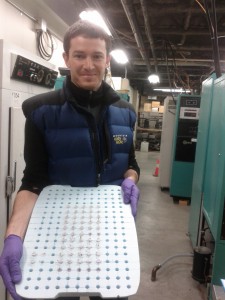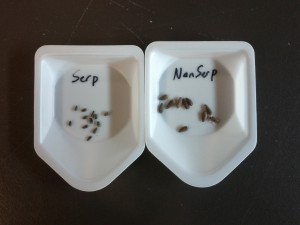I’m running some tests on my GBS data to look for population expansion. I know from looking at GBS data from an F1 genetic mapping population that for GBS data heterozygotes can be under called due to variation in amplification and digestions. Also, for my data observed heterozygosity is almost always under expected. Heterozygotes can also be overcalled when duplicated loci are aligned together. The tests I’m going to use explicitly use observed heterozygosity so this is worrying.
Tag Archives: exilis
Hydroponics test run
Dylan and I have been working on getting hydroponic testing up and running. The basic set up is a large tub filled with dilute nutrient solution, with aeration provided by an air pump. Floating on top of the water is a large foam sheet with holes. In each hole we put a 2 ml tube packed with rock wool and perlite along with a seedling. Extending below the hole is a large bubble tea straw to make sure the roots don’t tangle together while growing.
Seed size in H. exilis
Here is a curiosity I noticed while sorting seeds.
At one of my H. exilis sites (G136) there was a serpentine field beside a raised road. The field had a large population of tiny sunflowers, but there were also a few plants on the gravel embankment beside the road. These plants were much bigger, probably because the soil used in the embankment wasn’t serpentine. I collected seeds from both field and roadside plants.
The roadside seeds are much bigger than the serpentine seeds.
This has several possible explanations:
-Plasticity. The non-serpentine plants are much bigger, being bigger makes their seeds also larger.
-Selection. Bigger seeds are better on the disturbed habitat of the gravel embankment.
-Introgression. Gene flow from H. annuus could be coming in and only persisting on non-serpentine areas, bringing larger seed alleles.


